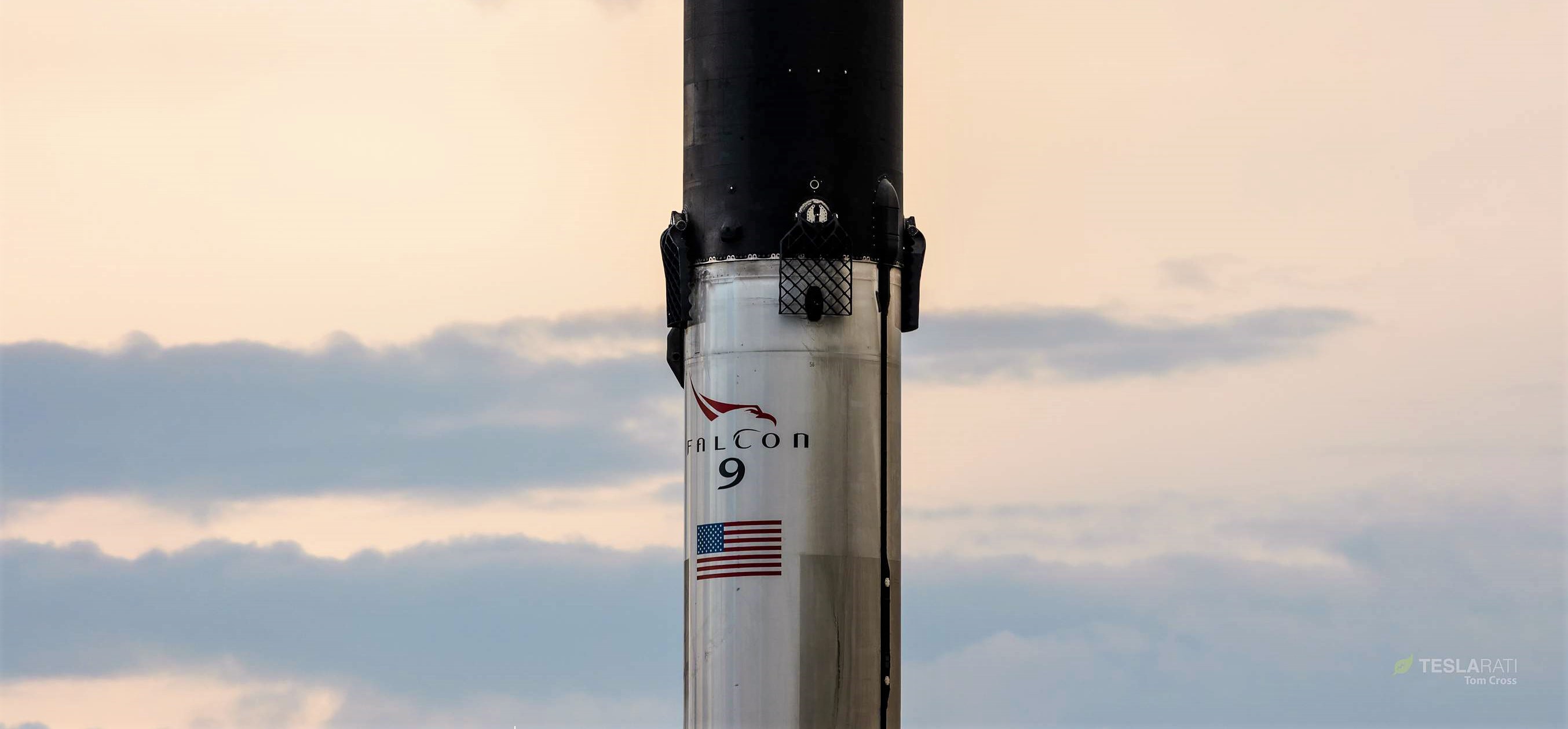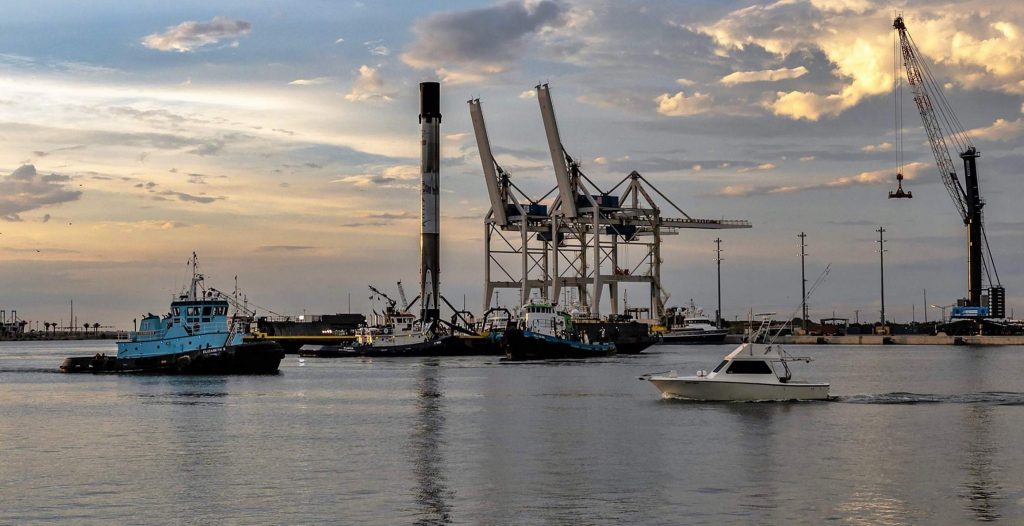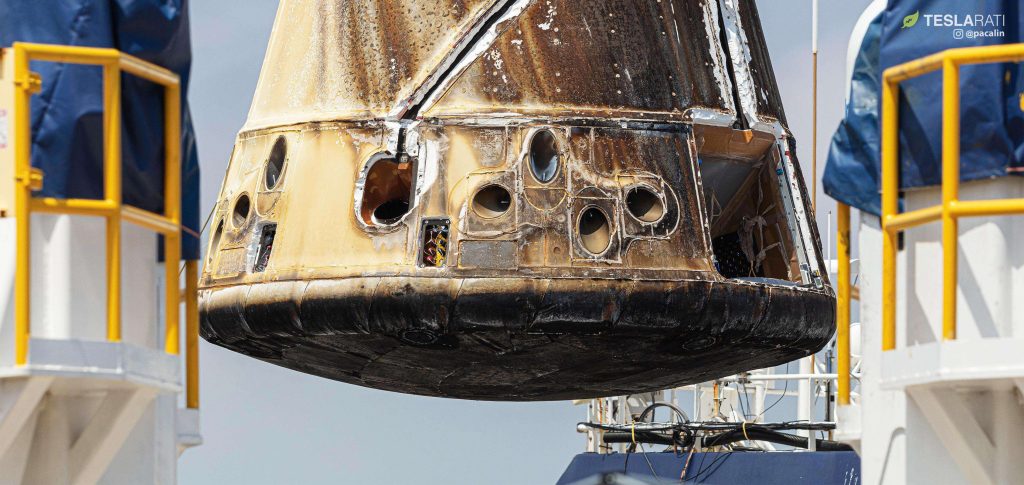

News
SpaceX Falcon 9 nears NASA’s first flight-proven Block 5 launch after static fire delays
After multiple days of delays, many a finger is crossed that SpaceX will be able to perform a critical static fire test of Falcon 9 booster B1056.1 on Friday morning (July 19th).
Falcon 9 B1056 and a fresh upper stage are scheduled to launch Cargo Dragon mission CRS-18 no earlier than 7:35 pm EDT (23:35 UTC), July 21st. As always, SpaceX requires each Falcon 9 rocket to successfully perform a static fire ignition test prior to declaring launch readiness, and B1056 was originally planned to be loaded with propellant and fire its nine Merin 1D engines on Wednesday, July 16th.
After a solid handful of slips, the test has most recently been rescheduled on Friday morning, a delay of 48 hours. SpaceX has demonstrated a three-day turnaround between static fire and launch with Falcon 9 Block 5, but a static fire delay beyond Friday – perhaps even beyond early Friday afternoon – will almost certainly push CRS-18’s launch back a day or two. If not, SpaceX is certainly cutting it close to make the current July 21st date.
In support of Cargo Dragon Commercial Resupply Mission-17 (CRS-17), Falcon 9 B1056 launched for the first time on May 4th, roughly 11 weeks (76 days) ago and 78 days before its planned return to flight. For both SpaceX and NASA, CRS-18 will be a fairly significant launch for a variety of reasons

Falcon2
First and foremost, Falcon 9 B1056 previously supported a NASA Cargo Dragon mission, as described above. Even before the booster successfully landed and returned to port, plans were already in order to essentially keep the booster “in family”, reusing it for NASA launches only. Discussed on Teslarati immediately after the subject was broached during a post-launch press conference, NASA manager Kenny Todd didn’t split hairs.
“Quite frankly, [NASA] had a vested interest in this particular booster. We were gonna require it – the intent is to [reuse B1056 on SpaceX’s upcoming CRS-18 launch] and – potentially – CRS-19.”
Kenny Todd, ISS Operations and Integration Manager, NASA Johnson
Not only will NASA fly Cargo Dragon’s CRS-18 mission on B1056, but the agency is already actively considering reusing the same Falcon 9 booster – assuming a successful launch and landing next week – on CRS-19, SpaceX’s second-to-last Dragon 1 (i.e. Cargo Dragon) launch. If all goes well with CRS-18, CRS-19 could come as early as December 2019, while CRS-20 – likely Dragon 1’s last launch ever – is scheduled no earlier than March 2020 and could certainly make use of B1056.3 if NASA is interested.
Dragon3
Meanwhile, although neither SpaceX or NASA have confirmed it, the Cargo Dragon capsule flight-proven Falcon 9 B1056 will itself be flight-proven – although that’s nothing shocking after a full half-dozen successful launches of reused capsules. What will be exceptional, however, is the likely event that CRS-18 will mark the first time that SpaceX has launched the same Cargo Dragon capsule on its third orbital mission.
Speaking all the way back in summer 2017, now two years distant, SpaceX CEO Elon Musk revealed that Cargo Dragon (Dragon 1) was designed at the outset to be reused three times. Almost exactly 24 months later, SpaceX is likely to prove that that is the case. Based on a list of known Dragon 1 capsules and their serial numbers, SpaceX has already launch and reused all but one of the last seven capsules built and successfully recovered. Capsule 107 (C107) supported CRS-5 in January 2015 and was successfully recovered one month later.

Aside from CRS-7 capsule C109, destroyed in June 2015 during Falcon 9’s first and only in-flight failure, all other capsules (C108-C113) have been successfully launched, recovered, and relaunched. As such, it seems extremely improbable that CRS-5 capsule C107 will be supporting CRS-18. Instead, one of SpaceX’s six twice-flight-proven orbital spacecraft has likely been refurbished for the final time, preparing to become the first orbital-class commercial spacecraft to be reused twice.
Thy Holy Stripe
Finally, it also appears that CRS-18 will mark the debut some sort of on-orbit Falcon upper stage test, hinted at by a grey ring wrapping what looks like just a portion of its fuel (RP-1/kerosene) tank. The objective of this modification is unclear, although chances are good that either NASASpaceflight.com or SpaceX itself will provide at least a bit more information in the coming days.
Check out Teslarati’s Marketplace! We offer Tesla accessories, including for the Tesla Cybertruck and Tesla Model 3.
News
Tesla launches in India with Model Y, showing pricing will be biggest challenge
Tesla finally got its Model Y launched in India, but it will surely come at a price for consumers.

Tesla has officially launched in India following years of delays, as it brought its Model Y to the market for the first time on Tuesday.
However, the launch showed that pricing is going to be its biggest challenge. The all-electric Model Y is priced significantly higher than in other major markets in which Tesla operates.
On Tuesday, Tesla’s Model Y went up for sale for 59,89,000 rupees for the Rear-Wheel Drive configuration, while the Long Range Rear-Wheel Drive was priced at 67,89,000.
This equates to $69,686 for the RWD and $78,994 for the Long Range RWD, a substantial markup compared to what these cars sell for in the United States.
🚨 Here’s the difference in price for the Tesla Model Y in the U.S. compared to India.
🚨 59,89,000 is $69,686
🚨 67,89,000 is $78,994 pic.twitter.com/7EUzyWLcED— TESLARATI (@Teslarati) July 15, 2025
Deliveries are currently scheduled for the third quarter, and it will be interesting to see how many units they can sell in the market at this price point.
The price includes tariffs and additional fees that are applied by the Indian government, which has aimed to work with foreign automakers to come to terms on lower duties that increase vehicle cost.
Tesla Model Y seen testing under wraps in India ahead of launch
There is a chance that these duties will be removed, which would create a more stable and affordable pricing model for Tesla in the future. President Trump and Indian Prime Minister Narendra Modi continue to iron out those details.
Maharashtra Chief Minister Devendra Fadnavis said to reporters outside the company’s new outlet in the region (via Reuters):
“In the future, we wish to see R&D and manufacturing done in India, and I am sure at an appropriate stage, Tesla will think about it.”
It appears to be eerily similar to the same “game of chicken” Tesla played with Indian government officials for the past few years. Tesla has always wanted to enter India, but was unable to do so due to these import duties.
India wanted Tesla to commit to building a Gigafactory in the country, but Tesla wanted to test demand first.
It seems this could be that demand test, and the duties are going to have a significant impact on what demand will actually be.
Elon Musk
Tesla ups Robotaxi fare price to another comical figure with service area expansion
Tesla upped its fare price for a Robotaxi ride from $4.20 to, you guessed it, $6.90.

Tesla has upped its fare price for the Robotaxi platform in Austin for the first time since its launch on June 22. The increase came on the same day that Tesla expanded its Service Area for the Robotaxi ride-hailing service, offering rides to a broader portion of the city.
The price is up from $4.20, a figure that many Tesla fans will find amusing, considering CEO Elon Musk has used that number, as well as ’69,’ as a light-hearted attempt at comedy over the past several years.
Musk confirmed yesterday that Tesla would up the price per ride from that $4.20 point to $6.90. Are we really surprised that is what the company decided on, as the expansion of the Service Area also took effect on Monday?
But the price is now a princely $6.90, as foretold in the prophecy 😂
— Elon Musk (@elonmusk) July 14, 2025
The Service Area expansion was also somewhat of a joke too, especially considering the shape of the new region where the driverless service can travel.
I wrote yesterday about how it might be funny, but in reality, it is more of a message to competitors that Tesla can expand in Austin wherever it wants at any time.
Tesla’s Robotaxi expansion wasn’t a joke, it was a warning to competitors
It was only a matter of time before the Robotaxi platform would subject riders to a higher, flat fee for a ride. This is primarily due to two reasons: the size of the access program is increasing, and, more importantly, the service area is expanding in size.
Tesla has already surpassed Waymo in Austin in terms of its service area, which is roughly five square miles larger. Waymo launched driverless rides to the public back in March, while Tesla’s just became available to a small group in June. Tesla has already expanded it, allowing new members to hail a ride from a driverless Model Y nearly every day.
The Robotaxi app is also becoming more robust as Tesla is adding new features with updates. It has already been updated on two occasions, with the most recent improvements being rolled out yesterday.
Tesla updates Robotaxi app with several big changes, including wider service area
News
Tesla Model Y and Model 3 dominate U.S. EV sales despite headwinds
Tesla’s two mainstream vehicles accounted for more than 40% of all EVs sold in the United States in Q2 2025.

Tesla’s Model Y and Model 3 remained the top-selling electric vehicles in the U.S. during Q2 2025, even as the broader EV market dipped 6.3% year-over-year.
The Model Y logged 86,120 units sold, followed by the Model 3 at 48,803. This means that Tesla’s two mainstream vehicles accounted for 43% of all EVs sold in the United States during the second quarter, as per data from Cox Automotive.
Tesla leads amid tax credit uncertainty and a tough first half
Tesla’s performance in Q2 is notable given a series of hurdles earlier in the year. The company temporarily paused Model Y deliveries in Q1 as it transitioned to the production of the new Model Y, and its retail presence was hit by protests and vandalism tied to political backlash against CEO Elon Musk. The fallout carried into Q2, yet Tesla’s two mass-market vehicles still outsold the next eight EVs combined.
Q2 marked just the third-ever YoY decline in quarterly EV sales, totaling 310,839 units. Electric vehicle sales, however, were still up 4.9% from Q1 and reached a record 607,089 units in the first half of 2025. Analysts also expect a surge in Q3 as buyers rush to qualify for federal EV tax credits before they expire on October 1, Cox Automotive noted in a post.
Legacy rivals gain ground, but Tesla holds its commanding lead
General Motors more than doubled its EV volume in the first half of 2025, selling over 78,000 units and boosting its EV market share to 12.9%. Chevrolet became the second-best-selling EV brand, pushing GM past Ford and Hyundai. Tesla, however, still retained a commanding 44.7% electric vehicle market share despite a 12% drop in in Q2 revenue, following a decline of almost 9% in Q1.
Incentives reached record highs in Q2, averaging 14.8% of transaction prices, roughly $8,500 per vehicle. As government support winds down, the used EV market is also gaining momentum, with over 100,000 used EVs sold in Q2.
Q2 2025 Kelley Blue Book EV Sales Report by Simon Alvarez on Scribd
-

 News3 days ago
News3 days agoTesla debuts hands-free Grok AI with update 2025.26: What you need to know
-

 Elon Musk6 days ago
Elon Musk6 days agoxAI launches Grok 4 with new $300/month SuperGrok Heavy subscription
-

 Elon Musk1 week ago
Elon Musk1 week agoElon Musk confirms Grok 4 launch on July 9 with livestream event
-

 News2 weeks ago
News2 weeks agoTesla Model 3 ranks as the safest new car in Europe for 2025, per Euro NCAP tests
-

 Elon Musk2 weeks ago
Elon Musk2 weeks agoxAI’s Memphis data center receives air permit despite community criticism
-

 News5 days ago
News5 days agoTesla begins Robotaxi certification push in Arizona: report
-

 Elon Musk2 weeks ago
Elon Musk2 weeks agoTesla reveals it is using AI to make factories more sustainable: here’s how
-

 Elon Musk2 weeks ago
Elon Musk2 weeks agoTesla scrambles after Musk sidekick exit, CEO takes over sales


















